LASIK Vision Correction Raleigh, NC | LASIK Raleigh
With age, vision gradually declines, even for people with perfect vision their entire lives. Slight changes in vision can make a difference in everyday life. The same is true for worsening vision in people who have worn glasses or contact lenses their entire lives. LASIK vision correction is the most popular and effective way to improve vision. Dr. Sumeet Jindal is an oculofacial cosmetic surgeon who specializes in reversing and improving the signs of aging, including worsening vision. The Jindal Institute For Youthful Aging (JIYA) provides the best LASIK surgery Raleigh, NC offers.

What Is LASIK?
LASIK is an acronym that stands for laser-assisted in situ keratomileusis. It is a laser refractive surgery that can improve vision and serve as an alternative to glasses or contacts. LASIK surgery achieves this by reshaping the cornea.
The cornea is the clear, dome-shaped portion of the eye. Several common vision problems such as myopia (nearsightedness), hyperopia (farsightedness), and astigmatism all are related to the shape of the cornea. A misshaped cornea causes the light to bend incorrectly which then results in blurred vision.
To better understand how this occurs and why LASIK can help, let’s look at how a misshapen cornea affects vision
- Nearsightedness: With myopia, the cornea may curve too sharply and/or the eyeball itself is too long. This causes light you refract primarily to the front of the retina and causes objects in the distance to look blurry and unclear. LASIK can help soften the curve of the cornea to help correct this.


- Farsightedness: Hyperopia occurs when the opposite is true and the cornea is too flat or the eyeball too short. This causes light to refract only behind the retina and then makes close and sometimes mid-distant objects appear blurry. LASIK can help to create more of a curve in the cornea.
- Astigmatism: An astigmatism is where the cornea curves and flattens unevenly which ends up affecting both near and far vision. In minor cases of an astigmatism, LASIK can help create a more even cornea and lessen vision obstruction.
Candidates
A common misconception is that anyone who wears glasses or contacts is a good candidate for LASIK vision correction. This is not true. Anyone with a very high eyeglass prescription is unlikely to qualify for LASIK. With that said, laser eye surgery candidates should meet with Dr. Jindal to determine if they are a good candidate.
Some conditions that may limit candidacy for LASIK include:
- Have fairly good vision/do not wear corrective lenses at all
- Large pupils
- Thin corneas
- Conditions that cause the cornea to bulge or thin over time
- Prescription frequently fluctuates and/or has changed in the past year
- Severe nearsightedness
- Dry eye syndrome
- Play contact sports
- Lazy eye
- Have a medical condition that may affect the healing process
- Anyone who is pregnant or nursing
- Patients under 18
- Unrealistic expectations

Benefits & Risks
LASIK vision correction—like all surgical procedures—comes with benefits and risks. Patients need to consider both carefully and talk with Dr. Jindal to determine whether LASIK is the right choice.
The benefits of LASIK include:
- Overall corrected vision (most people will achieve a result of at least 20/25 vision)
- Reduced or eliminated the need to continue wearing glasses or contacts
- Permanent results
- Performed in 30 minutes or less
- No general anesthesia
- Results are seen within one day
- No bandages or stitches
- High success rate
The risks of LASIK may include:
- Dry eyes
- Under correction or over correction
- Development of an astigmatism
- Infection
- Blepharitis
- Vision begins to return to pre-surgery
- Double vision
Many of these complications are treatable and will not result in lasting issues. Patients who are ideal candidates rarely experience major complications or side effects.


LASIK Surgery Before & After
Consultation
At a consultation with Dr. Jindal at the Jindal Institute For Youthful Aging, he will discuss the patient’s medical history and eye health. He may ask questions about present eye conditions, any previous eye surgeries, medications, and current and past prescriptions. Dr. Jindal may then also perform an exam himself. This includes taking measurements of the cornea and its thickness using wavefront-guided technology.
Dr. Jindal can then determine if the patient is a good candidate. He will then describe the procedure, the benefits and risks, and what that patient can realistically expect based on their prescription and history.
Surgery
LASIK surgery takes 30 minutes or less. The patient will have numbing eye drops administered. Some patients may choose to take medication to keep them relaxed, but this is not required. Dr. Jindal will then use instrumentation to keep the eye open and place a suction ring.
Using the laser, Dr. Jindal will carefully cut a flap in the cornea. This allows him to access the lower layers of the corner that can be reshaped. Using a programmed laser, Dr. Jindal will reshape the corneal tissue as necessary to provide the best possible result.
Patients should not feel pain during the procedure beyond some light pressure. They are asked to focus on a light. Occasionally, patients may notice a smell similar to burned hair. This is normal.
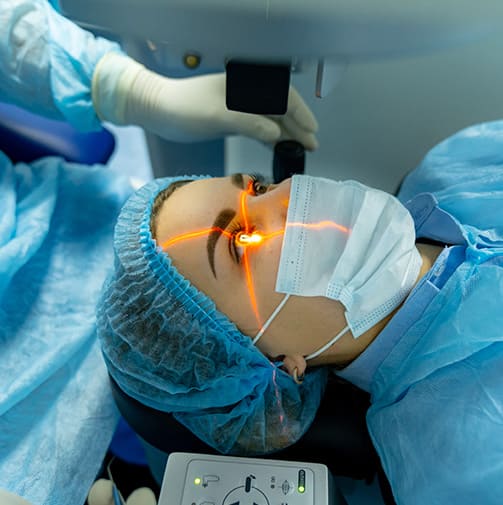

Recovery
After surgery, patients will likely experience blurred vision. As the numbing wears off, the eyes may feel dry, gritty, or generally itchy. This can also cause excess watering of the eye. These side effects should improve relatively quickly and patients recover full vision by the next day at the latest. Dr. Jindal may advise patients to wear an eye shield at night.
Patients can usually return to most activities within a couple of days. However, it will take about two to three months for vision to fully adjust and stabilize. Bouts of blurry vision may continue, but should not interfere majorly with life. Using makeup or cosmetics around the eyes and playing sports or strenuous exercise may need to be discontinued for several weeks so the eye can properly heal.
Before & After
UltraClear™ Acne Scars Treatment

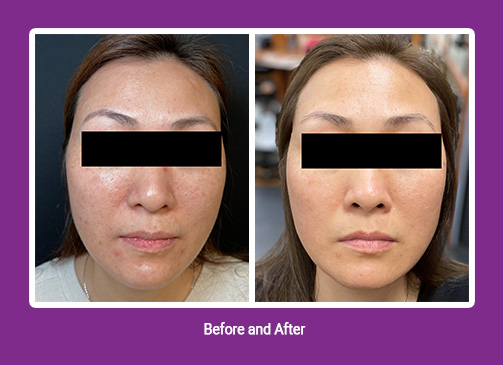
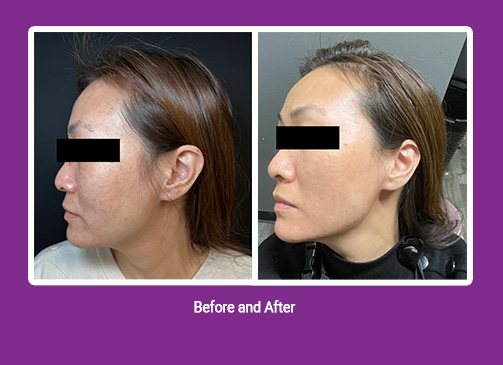
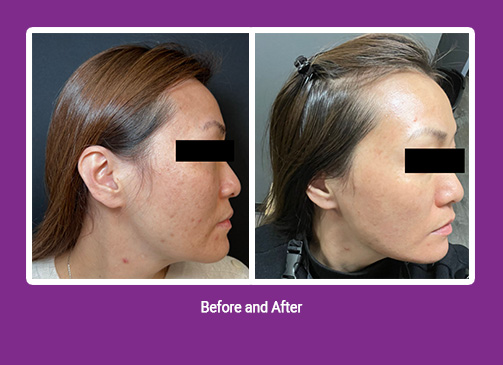
Frequently Asked Questions
While any adult may qualify for a LASIK procedure, it is generally recommended for patients between 30 and 45. In younger patients, their prescription may not be stable or they may see changes until their early to mid-twenties. Older patients are more likely to need cataract surgery which can have some of the same benefits of LASIK vision correction. Thus, a separate procedure is usually unnecessary.
No, patients should not feel any pain after the procedure. Afterward, some pain or discomfort is normal, but over-the-counter pain medications normally help patients manage their pain without issue.
Regular contact wearing can alter the shape of the cornea over time. Therefore, for a few weeks before LASIK vision correction, patients will need to stop wearing their contact lenses. Glasses do not have this effect and can be worn before and after the procedure.
The exact cost of LASIK varies, but it averages around $2,000 per eye. It is considered a fully elective procedure and thus is not covered by medical insurance.
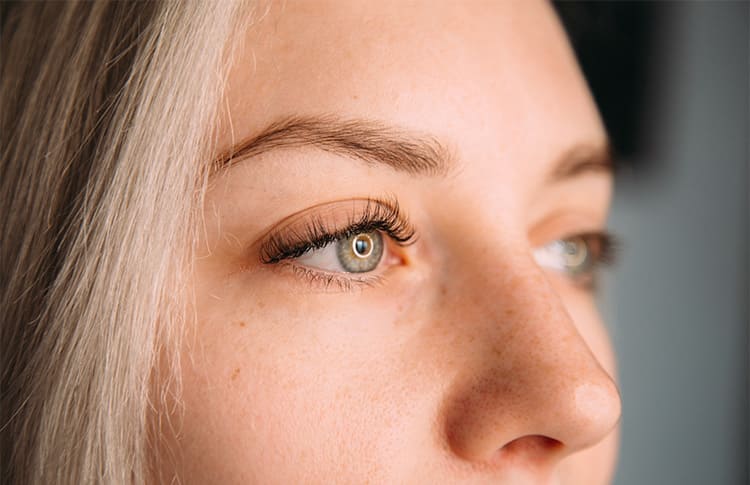
The Best LASIK Surgery In Raleigh By Dr. Jindal
Dr. Sumeet Jindal is a triple board certified surgeon who has certifications in ophthalmology, laser surgery, and cosmetic surgery. This makes him one of the most qualified surgeons in the Raleigh, North Carolina area for LASIK vision correction. The Jindal Institute For Youthful Aging offers the best LASIK surgery Raleigh, NC provides.
To learn more and schedule a consultation, call us at 919-861-4494 ext. 3. Patients can also reach out online via chat contact form or Price Simulator.
